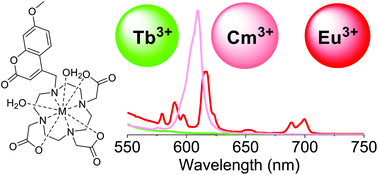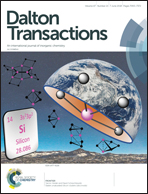Investigating subtle 4f vs. 5f coordination differences using kinetically inert Eu(iii), Tb(iii), and Cm(iii) complexes of a coumarin-appended 1,4,7,10-tetraazacyclododecane-1,4,7-triacetate (DO3A) ligand†
Abstract
In order to reveal subtle differences between the solution chemistries of trivalent 4f and 5f elements, the physicochemical and photophysical properties of europium(III), terbium(III) and curium(III) complexes formed with a 7-methoxy-coumarin appended 1,4,7,10-tetraazadodecane-1,4,7-triacid (DO3A) ligand were studied. All three complexes were found to be kinetically inert and exhibit stability constants similar to their 1,4,7,10-tetraazacyclododecane-1,4,7,10-tetraacetic acid (DOTA) equivalents. The Cm(III) and Eu(III) complexes feature strong sensitised emission, while the triplet energy of the coumarin prohibits efficient sensitisation of the Tb(III) analogue. The data presented here indicate significant differences in perturbation of the sensitising chromophore photophysics between the 4f and 5f elements. In contrast, the size of the metal center appears to not be a determining factor for the physicochemical properties of these kinetically inert Eu(III), Tb(III), and Cm(III) complexes.



 Please wait while we load your content...
Please wait while we load your content...
